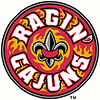|
|
HOME ~ College Football History |
University
of Louisiana Lafayette
After years of achievement and leadership in higher education and five
years of planning and lobbying, UL President Dr. Ray Authement was
rewarded for his determination on April 27, 1984 as the Board of
Trustees for State Colleges and Universities voted by a 17-1 margin to
drop the “Southwestern” from USL’s name. On that date, the University of
Southwestern Louisiana became THE University of Louisiana.
By that time, USL’s name had become a hindrance to further advancement
and improvement among universities. UL had outgrown its
double-directional name. UL’s enrollment was at 16,000 students, which
made it one of the
 two largest schools in the three-state region of
Louisiana, Mississippi, and Arkansas. It was a comprehensive university
and had students from all 50 states and 100 countries enrolled. UL lead
the state in professional and certification exams in many fields
including engineering, nursing, and education. The University of
Louisiana had received national recognition for their computer science
program and was a charter member of NCAA Division I-A Football. two largest schools in the three-state region of
Louisiana, Mississippi, and Arkansas. It was a comprehensive university
and had students from all 50 states and 100 countries enrolled. UL lead
the state in professional and certification exams in many fields
including engineering, nursing, and education. The University of
Louisiana had received national recognition for their computer science
program and was a charter member of NCAA Division I-A Football.
The name didn’t last long, however, as some administrators at other
state schools worried that UL’s new name would diminish their image. In
May of 1984, the Board Regents, with the strong support of powerful LSU
backers on and off the Board, took the issue to district court,
asserting that only the Louisiana Legislature could rename state
universities. They won and District Judge William H. Brown stripped the
University of Louisiana of its new name. UL was ordered to revert to USL
on May 22, 1984. Soon after and in specific response to this case, the
state legislature changed state law to require that only the legislature
could change the name of state colleges and universities.
But the fight was not over for a name that was more reflective of the
University’s accomplishments, achievements, and stature. In 1995, the
Louisiana State Legislature to agree to allow the change. However, Act
45 required a compromise that has become known as the “LSU Rule.” The
LSU Rule required that at least two state universities change their name
at the same time. It required that all universities who change their
name change it to “University of Louisiana at [city designation].”
Northeast Louisiana University hesitated and stalled but in 1999
Northeast’s Lawson Swearingen finally agreed to the name change. The
Board of Regents and the UL Board of Supervisors finally approved the
name change in late August 1999. USL became UL Lafayette and NLU became
UL Monroe. USL officials decided to make it official at the Centennial
Spectacular kicking off the yearlong celebration of the university’s
100th birthday. University of Louisiana was now a reality.
Fortunately, the legislative law regarding the name change only applies
to university and state employees. This state policy does not govern UL
alumni, supporters, other universities, and certainly not the autonomy
of the press. This leaves the door open for UL Lafayette to be commonly
and popularly known as LOUISIANA, while maintaining the official name.
Victory Run
Texans have a special reverence for the State "Lone Star" Flag and their
"Stand Alone" attitude and historical past such as the Alamo, all
contribute to this reverence. It is no wonder that during the pre-game
ceremonies when the huge Texas state flag is unfurled and carried on the
field, the crowd roars with excitement. Since LSU is now the University
of Louisiana, fans decided to honor thir state flag with such a
tradition.
On February 23, 2001, Advertising Flag Co., Inc. was authorized to
proceed with the manufacture of a state flag of Louisiana measuring 53'
x 80' with 70 sewn-in handles with Memorial Day as a completion date.
The edges of the flag are embroidered with the dates of every victory UL
has enjoied since 1908. On Monday, July 2, 2001, the flag was delivered
to Thibodaux in a box 42" x 42" x 12" weighing 160 lbs. The flag was
named "Louisiana" since the tradition will relate to and honor all of
Louisiana and all of the rich history of the state.
Unfortunately, due to a legal review dug up a Louisiana statute that
prohibits adding anything to the state flag, the planned embroidery on
the flag would be considered flag desecration and a felony. With the
embroidery almost completed, a change of direction was needed. Five
smaller flags (58" x 96") were produced. One side red with "Ragin'
Cajuns" in black and white. The other side of each flag would sport 100
blue embroidered victories 30" x 80" set on black with 8" white letters
showing "100 Victories" (for the first 100 victories) and "200
Victories" (for the second 100 victories) and so on with the fifth flag
indicating 500 victories with the final 31 victories embroidered. These
victory flags are paraded and waved by five cheerleaders ahead of the
large flag as it is brought on the field and ahead of the Ragin' Cajun
team as it comes out of the tunnel.
Louisiana’s Victory Run finally occurred during the pre-game ceremonies
of the Southern Mississippi - UL contest. Chi Alpha Christian
Fellowship, Louisiana, and the five victory flags were introduced to the
field. With the first exposure of Louisiana’s Victory Run, the tradition
was finally begun.
Home Page 
|

